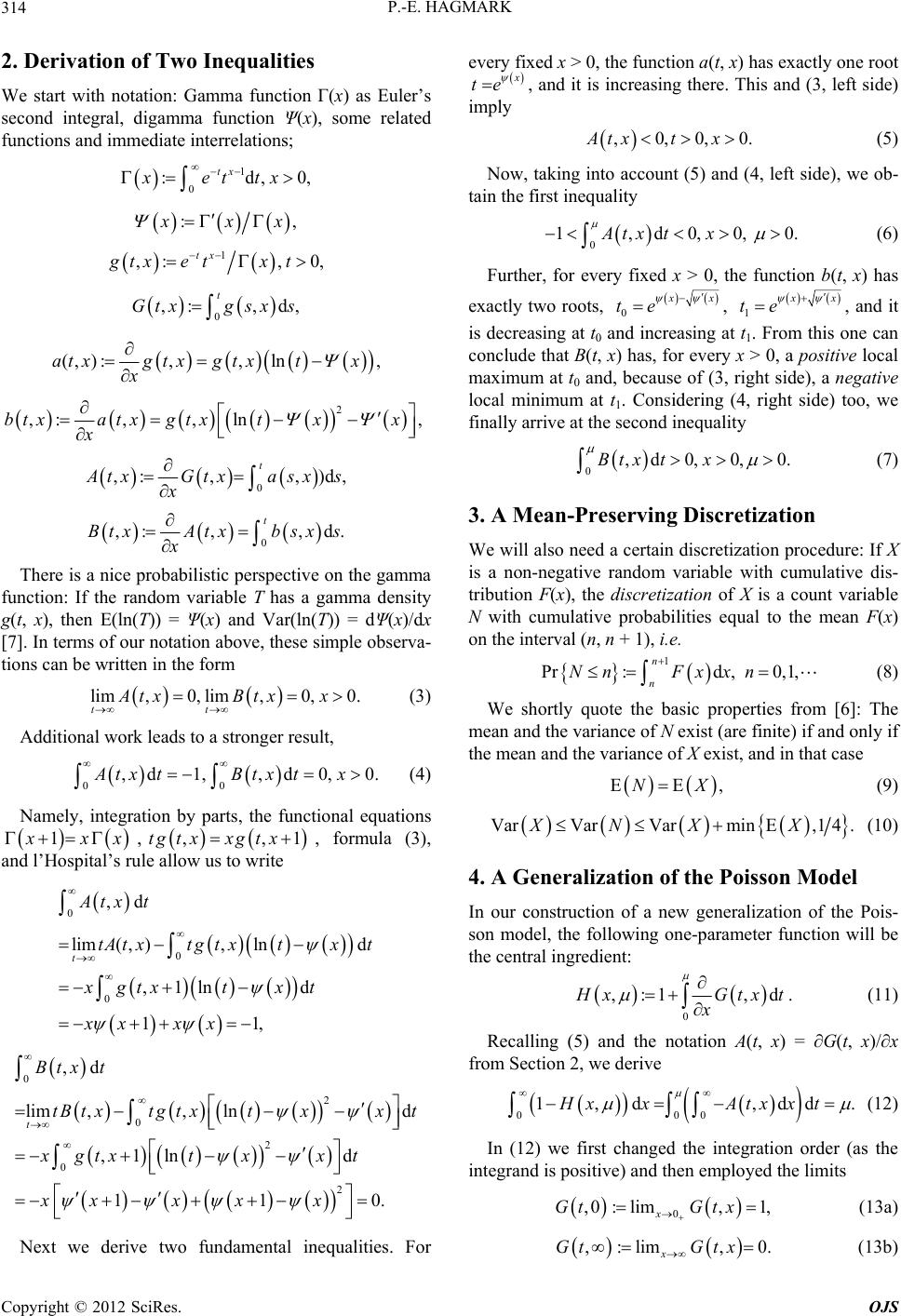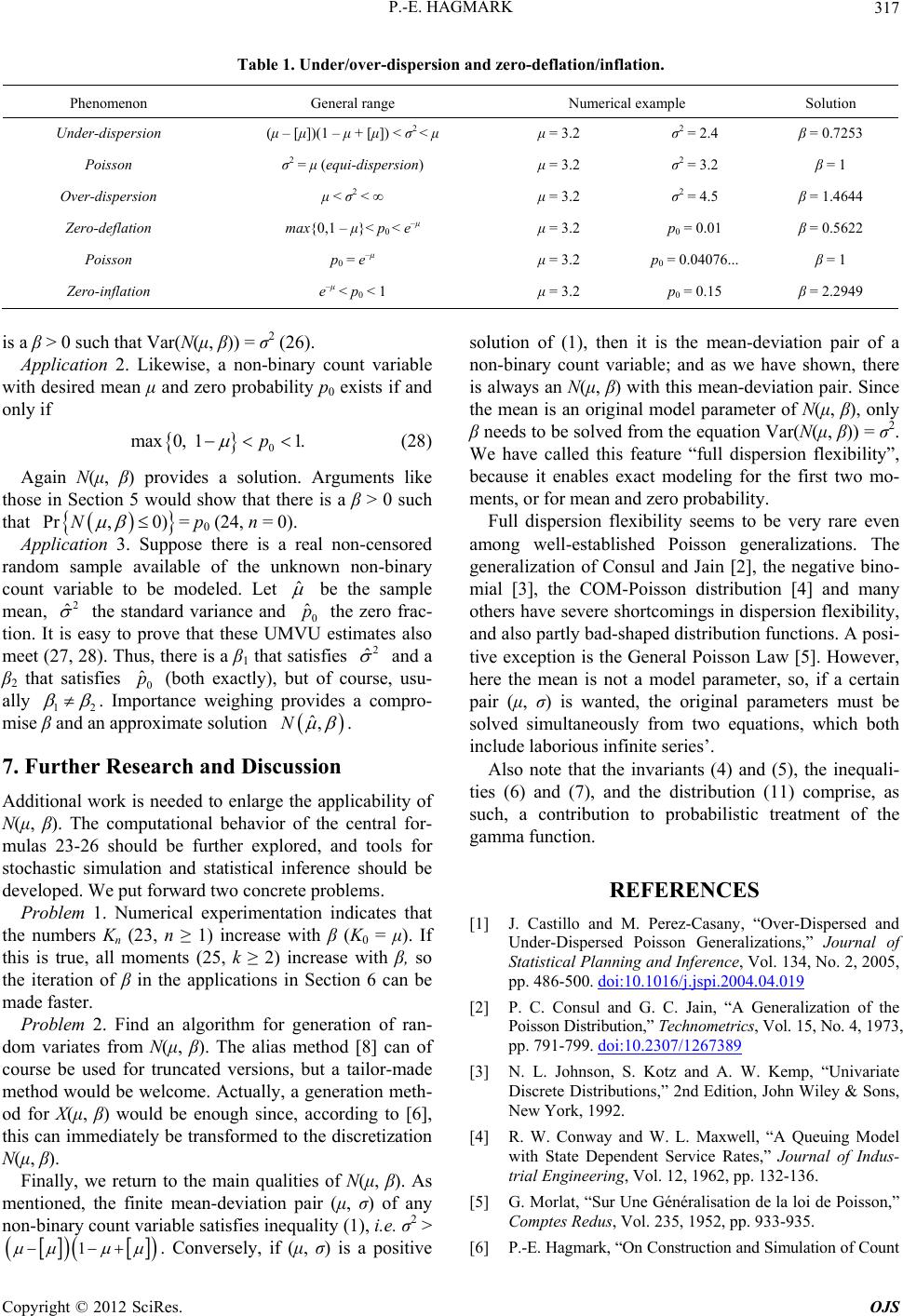 Open Journal of Statistics, 2012, 2, 313-318 http://dx.doi.org/10.4236/ojs.2012.23039 Published Online July 2012 (http://www.SciRP.org/journal/ojs) An Exceptional Generalization of the Poisson Distribution Per-Erik Hagmark Department of Mechanics and Design, Tampere University of Technology, Tampere, Finland Email: per-erik.hagmark@tut.fi Received May 4, 2012; revised June 10, 2012; accepted June 23, 2012 ABSTRACT A new two-parameter count distribution is derived starting with probabilistic arguments around the gamma function and the digamma function. This model is a generalization of the Poisson model with a noteworthy assortment of qualities. For example, the mean is the main model parameter; any possible non-trivial variance or zero probability can be at- tained by changing the other model parameter; and all distributions are visually natural-shaped. Thus, exact modeling to any degree of over/under-dispersion or zero-inflation/deflation is possible. Keywords: Count Data; Gamma Function; Poisson Generalization; Discretization; Modeling; Over/Under-Dispersion; Zero-Inflation/Deflation 1. Introduction and the Main Result In count data modeling the Poisson distribution is usually the first option, but real data can indicate a variety of discrepancies. These can be genuine features or secon- dary consequences of e.g. censoring, clustering, approxi- mations or correlations. Specifically, the Poisson model has no dispersion flexibility because the mean determines the variance and the zero probability, σ2 = μ, p0 = e–μ, while the real data can display over or under- dispersion, σ2 ≠ μ, or zero-inflation or deflation, p0 ≠ e–μ [1]. Such situations are usually handled e.g. by randomizing the Poisson mean, by mixtures, by adding a new parameter, by reweighing the Poisson point probabilities, or via generalizing the exponential increments in the homoge- neous Poisson process [2-5]. Our approach will be dif- ferent. We recall an elementary fact. The mean-deviation pair (μ, σ) of a non-binary count variable (non-negative inte- ger-valued random variable) always satisfies the inequal- ity 1 2 , (1) where [μ] is the largest integer not exceeding μ. Thus, we will say that a count model (parameterized count variable) has full dispersion flexibility if every positive solution (μ, σ) of the inequality (1) is the mean-deviation pair for some parameter values. In [6] we called for a mathematically unified count model N(μ, β) with two independent parameters, µ > 0, β > 0, and the following properties: 1) Comfortable parameterization: E(N(μ, β)) = μ, for all μ and β. 2) Generalization of the Poisson model: For β = 1, Pr ,1! n Nμne n , n = 0, 1, ···. 3) Full dispersion flexibility: If the numbers μ > 0 and σ > 0 satisfy inequality (1), then there is a β such that 2 Var ,N . The solution to be presented in this paper obeys the following cumulative probabilities: Pr 1,,1 11 1, 1,1, Nμ,βn nn nG ng nn nG ng (2) where g(t, x) and G(t, x) are the one-parameter gamma probability and cumulative distribution functions, respec- tively, with parameter x and variable t (Section 2). We begin with the derivation of fundamental inequali- ties in Section 2. These inequalities lead to a cumulative distribution H(x, μ), where the parameter μ > 0 is the mean. Then the insertion of a new independent parameter β > 0 provides an extended cumulative distribution H(x/β, μ/β) and the related non-negative two-parameter random variable X(μ, β), where μ is still the mean. Now the pro- claimed count model N(μ, β) is defined as a mean-pre- serving discretization of X(μ, β), and the above properties 1), 2), 3) are proved. Thereafter the most immediate ap- plications are given; namely, exact modeling of over/ under-dispersion or zero-inflation/deflation to any possi- ble degree. In the last section, we propose motives for further research, and we compare N(μ, β) with well-es- tablished Poisson generalizations. C opyright © 2012 SciRes. OJS  P.-E. HAGMARK 314 2. Derivation of Two Inequalities We start with notation: Gamma function Г(x) as Euler’s second integral, digamma function Ψ(x), some related functions and immediate interrelations; 0 xe 1 :d,0, tx ttx :, xx 1 ,: tx gtxe t , 0,x t 0,d, tgsxs ,:Gtx (, ):,,lat xgt xgt x x n ,t x 2 ,:,, ln,btxatx gtxtxx x 0 ,: ,,)d, t txGtxasx s ,: ,Btx Atx 0,d. tbsxs lim ,0,lim ,0,0 tt AtxBtx x 00 ,d1,,d 0,0Atx tBtx tx There is a nice probabilistic perspective on the gamma function: If the random variable T has a gamma density g(t, x), then E(ln(T)) = Ψ(x) and Var(ln(T)) = dΨ(x)/dx [7]. In terms of our notation above, these simple observa- tions can be written in the form . (3) Additional work leads to a stronger result, . (4) Namely, integration by parts, the functional equations 1 xx ,tgtx xgtx,, formula (3), and l’Hospital’s rule allow us to write ,1 0 d d , tx t x t 2 2 d d 0. x t xt x ,dAtx t 0 0 lim(,),ln ,1ln 11 tt Atx tgtx xgtx t xx xx 0,dBtx t 0 2 0 lim ,, ln ,1ln 11 tt Btx tgtxtx xgtxtx xxx x Next we derive two fundamental inequalities. For every fixed x > 0, the function a(t, x) has exactly one root te , and it is increasing there. This and (3, left side) imply ,0,0,0.Atxtx 0 1,d0,0, 0.Atx tx (5) Now, taking into account (5) and (4, left side), we ob- tain the first inequality (6) Further, for every fixed x > 0, the function b(t, x) has exactly two roots, 0 x te , 1 x te 0,d 0,0,0Btx tx , and it is decreasing at t0 and increasing at t1. From this one can conclude that B(t, x) has, for every x > 0, a positive local maximum at t0 and, because of (3, right side), a negative local minimum at t1. Considering (4, right side) too, we finally arrive at the second inequality . 1 Pr:d,0,1, n n Nn Fxxn (7) 3. A Mean-Preserving Discretization We will also need a certain discretization procedure: If X is a non-negative random variable with cumulative dis- tribution F(x), the discretization of X is a count variable N with cumulative probabilities equal to the mean F(x) on the interval (n, n + 1), i.e. (8) We shortly quote the basic properties from [6]: The mean and the variance of N exist (are finite) if and only if the mean and the variance of X exist, and in that case EE,NX (9) VarVarVarminE,14.XNXX (10) 4. A Generalization of the Poisson Model In our construction of a new generalization of the Pois- son model, the following one-parameter function will be the central ingredient: 0 ,:1 ,d xGtxt x 000 1,d,ddHxxAtx x t . (11) Recalling (5) and the notation A(t, x) = ∂G(t, x)/∂x from Section 2, we derive . (12) In (12) we first changed the integration order (as the integrand is positive) and then employed the limits 0 ,0 :lim,1, x Gt Gtx (13a) ,:lim, 0 x Gt Gtx . (13b) Copyright © 2012 SciRes. OJS  P.-E. HAGMARK Copyright © 2012 SciRes. OJS 315 ,Hx The limits (13) follow from Chebyshev’s inequality and the simple fact that the parameter x of the one-pa- rameter gamma density g(t, x) equals the mean and the variance. By employing the inequalities (6) and (7), we have 0 < H(x, μ) < 1 and ∂H(x, μ)/∂x > 0. Hence, H(x, μ) is a cu- mulative probability distribution with mean μ (12) and zero probability0x 0,: limH . We proceed by adding an independent parameter β > 0, so defining a two-parameter cumulative distribution, ,, :Fx H , ,0. xx (14) Now, let X(μ, β) be the non-negative random variable determined by F(x, μ, β), and let N(μ, β) be the discreti- zation of X(μ, β), according to Section 3. We form an integral function of (14) and get the cumulative prob- abilities of N(μ, β) using (8): 0 0 ,, :,IxFx , d ,d ,d, x x Gs s tx Gt (15) 0 ,,:Pr, ) 1, ,, , 1, PnN n In In tn GG 1 ,d tn t (16) 0 E, E, 1,d E,1 , x Nμβ Xμβ x ββ X (17) proving Property 1). Next, we fix β = 1 in (16) and em- ploy the identities G(t, x) – G(t, x + 1) = g(t, x + 1) and G(t, 0) = 1 (13a). Now Pr{N(μ, 1) ≤ n} = 1 – G(μ, n + 1), so the point probabilities are Pr{N(μ, 1) = n} = G(μ, n) – G(μ, n + 1) = ! n en , n = 0, 1, ···. This means that the sub-model N(μ, 1) is the Poisson model, so Property 2) holds true (see case β = 1 in Figure 1). 5. Full Dispersion Flexibility Property 3), Section 1, remains to be proved. Given any positive pair (μ, σ) satisfying 21 , we have to prove that there is a β > 0 such that Var(N(μ, β)) = σ2. Figure 2 is an illustration. First, one obtains an upper bound for the variance of X(μ, β) by employing Properties 1) and 2), (10, left side) and routines: The pair X(μ, β) and N(μ, β) is illustrated in F i gure 1. Proof of Properties 1) and 2), Section 1. By consider- ing (9, 12, 14) one can see that the mean does not change during the process from H(x, μ) to N(μ, β): 2 0 2 22 2 2 Var,2 1,d E,1 Var ,1 Var,1 . XxHxx X X N (18) Then (18) and (10, right side) imply Var(N(μ, β)) < ∞. After noting that Var(N(μ, β)) is a continuous function of β (for fixed μ) and recalling inequality (1), it is enough to prove the following limits: 0 1limVar, ,N (19) lim Var, N (20) Figure 1. Cumulative distributions of X(μ, β) and N(μ, β), for μ = 3.2 and β = 1, 0.6, 4, 0.1.  P.-E. HAGMARK 316 Figure 2. The variance Var(N(μ, β)) as a function of β, for μ = 3.2 and μ = 0.7. Poisson point (β = 1, σ2 = μ); lower bound 2 min σμ=1+μμ 0 ,dd. M . Proof of (19). From (18) it follows that Var(X(μ, β)) tends to zero as β→0. This means that X(μ, β) approaches the constant µ (in distribution). This again means that the discretization N(μ, β) approaches μ if this is an integer, and otherwise a binary count variable with the values [μ] and [μ]+1; see [6]. In both cases the limit of Var(N(μ, β)) obeys (19). Proof of (20). Definition (11) and partial integration yield the identity 0 00 1,d ,d M xHx x GtM t Gtxtx 21 ,d 2dd, The first term on the right side vanishes when M→∞, since MG(t, M) ≤ tM/Г(M). Now by changing the integra- tion order in the latter term, one obtains 0 00 E,1 2 t xHx x sst L (21) where 1d sx Lsgsxx esxx 00 :,d. Then, by using (21) and part of (18), and changing in- tegration variable, z = βt, one arrives at 22 2,1 2dd.zLssz 111ln x 0 0 E, E z z XX (22) Further, the inequality xs ln , sCD s , s > 0, x > 0, yields a lower bound for L(s): 0,dLsgsxx e 1 11 00 11 d0, d0. x CxDx xx This means that L(s) tends to ∞ as s→0, and so the av- erage of L in the interval (0, z/β) approaches ∞ as β→∞ (22). Thereby, E(X(μ, β)2) grows to ∞, so (17) and (10, left side) complete the proof of (20). 6. Computing and Applications When working with N(μ, β), the following numbers are useful: 0 , :,d ,,1, 0,1, n K tn Gt nn nG ngn (23) The latter faster version follows from partial integra- tion and the identities G(t, x) – G(t, x + 1) = g(t, x + 1), G(t, 0) = 1 (13a). Note also that most mathematical soft- ware offers fast computation of G(t, x). Employing (23) in (16), basic formulas can be written in the following form: 1 Pr,) 1,, , nn NnK K 24) 1 E, 12 1,, k kk k n n N nnnK 2 1 Var, 2,. n n NK (25) (26) We consider exact modeling of count variables. (For numerical examples, see Table 1). Application 1. Generally, a non-binary count variable with desired mean μ and variance σ2 exists if and only if 2 1. (27) In that case N(μ, β) always provides a solution. Indeed, because of full dispersion flexibility, Property 3), there Copyright © 2012 SciRes. OJS  P.-E. HAGMARK 317 Table 1. Under/over-dispersion and zero-deflation/inflation. Phenomenon General range Numerical example Solution Under-dispersion (μ – [μ])(1 – μ + [μ]) < σ2 < μ μ = 3.2 σ2 = 2.4 β = 0.7253 Poisson σ2 = μ (equi-dispersion) μ = 3.2 σ2 = 3.2 β = 1 Over-dispersion μ < σ2 < ∞ μ = 3.2 σ2 = 4.5 β = 1.4644 Zero-deflation max{0,1 – μ}< p0 < e–μ μ = 3.2 p0 = 0.01 β = 0.5622 Poisson p0 = e–μ μ = 3.2 p0 = 0.04076... β = 1 Zero-inflation e–μ < p0 < 1 μ = 3.2 p0 = 0.15 β = 2.2949 is a β > 0 such that Var(N(μ, β)) = σ2 (26). Application 2. Likewise, a non-binary count variable with desired mean μ and zero probability p0 exists if and only if 0 max0, 11.p Pr, 0)N ˆ (28) Again N(μ, β) provides a solution. Arguments like those in Section 5 would show that there is a β > 0 such that = p0 (24, n = 0). Application 3. Suppose there is a real non-censored random sample available of the unknown non-binary count variable to be modeled. Let be the sample mean, 2 ˆ the standard variance and 0 the zero frac- tion. It is easy to prove that these UMVU estimates also meet (27, 28). Thus, there is a β1 that satisfies ˆ p 2 ˆ and a β2 that satisfies 0 (both exactly), but of course, usu- ally 12 ˆ p ˆ,N . Importance weighing provides a compro- mise β and an approximate solution . 7. Further Research and Discussion Additional work is needed to enlarge the applicability of N(μ, β). The computational behavior of the central for- mulas 23-26 should be further explored, and tools for stochastic simulation and statistical inference should be developed. We put forward two concrete problems. Problem 1. Numerical experimentation indicates that the numbers Kn (23, n ≥ 1) increase with β (K0 = μ). If this is true, all moments (25, k ≥ 2) increase with β, so the iteration of β in the applications in Section 6 can be made faster. Problem 2. Find an algorithm for generation of ran- dom variates from N(μ, β). The alias method [8] can of course be used for truncated versions, but a tailor-made method would be welcome. Actually, a generation meth- od for X(μ, β) would be enough since, according to [6], this can immediately be transformed to the discretization N(μ, β). Finally, we return to the main qualities of N(μ, β). As mentioned, the finite mean-deviation pair (μ, σ) of any non-binary count variable satisfies inequality (1), i.e. σ2 > 1 . Conversely, if (μ, σ) is a positive solution of (1), then it is the mean-deviation pair of a non-binary count variable; and as we have shown, there is always an N(μ, β) with this mean-deviation pair. Since the mean is an original model parameter of N(μ, β), only β needs to be solved from the equation Var(N(μ, β)) = σ2. We have called this feature “full dispersion flexibility”, because it enables exact modeling for the first two mo- ments, or for mean and zero probability. Full dispersion flexibility seems to be very rare even among well-established Poisson generalizations. The generalization of Consul and Jain [2], the negative bino- mial [3], the COM-Poisson distribution [4] and many others have severe shortcomings in dispersion flexibility, and also partly bad-shaped distribution functions. A posi- tive exception is the General Poisson Law [5]. However, here the mean is not a model parameter, so, if a certain pair (μ, σ) is wanted, the original parameters must be solved simultaneously from two equations, which both include laborious infinite series’. Also note that the invariants (4) and (5), the inequali- ties (6) and (7), and the distribution (11) comprise, as such, a contribution to probabilistic treatment of the gamma function. REFERENCES [1] J. Castillo and M. Perez-Casany, “Over-Dispersed and Under-Dispersed Poisson Generalizations,” Journal of Statistical Planning and Inference, Vol. 134, No. 2, 2005, pp. 486-500. doi:10.1016/j.jspi.2004.04.019 [2] P. C. Consul and G. C. Jain, “A Generalization of the Poisson Distribution,” Technometrics, Vol. 15, No. 4, 1973, pp. 791-799. doi:10.2307/1267389 [3] N. L. Johnson, S. Kotz and A. W. Kemp, “Univariate Discrete Distributions,” 2nd Edition, John Wiley & Sons, New York, 1992. [4] R. W. Conway and W. L. Maxwell, “A Queuing Model with State Dependent Service Rates,” Journal of Indus- trial Engineering, Vol. 12, 1962, pp. 132-136. [5] G. Morlat, “Sur Une Généralisation de la loi de Poisson,” Comptes Redus, Vol. 235, 1952, pp. 933-935. [6] P.-E. Hagmark, “On Construction and Simulation of Count Copyright © 2012 SciRes. OJS  P.-E. HAGMARK 318 Data Models,” Mathematics and Computers in Simulation, Vol. 77, No. 1, 2008, pp. 72-80. doi:10.1016/j.matcom.2007.01.037 [7] L. Gordon, “A Stochastic Approach to the Gamma Func- tion,” The American Mathematical Monthly, Vol. 101, No. 9, 1994, pp. 858-865. [8] A. J. Walker, “An Efficient Method for Generating Dis- crete Random Variables with General Distributions,” ACM Transactions on Mathematical Software, Vol. 3, 1977, pp. 253-256. doi:10.1145/355744.355749 Copyright © 2012 SciRes. OJS
|